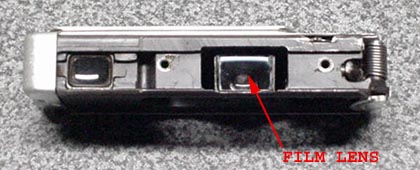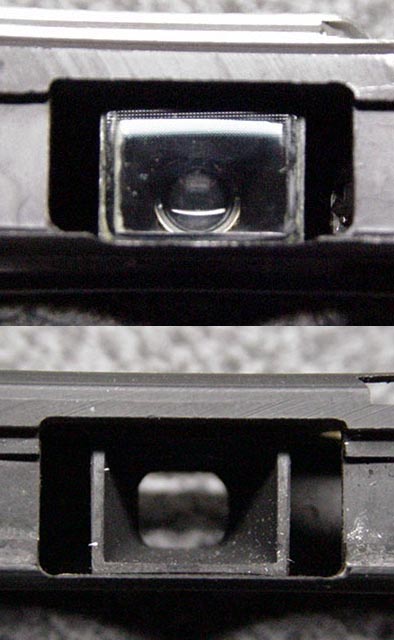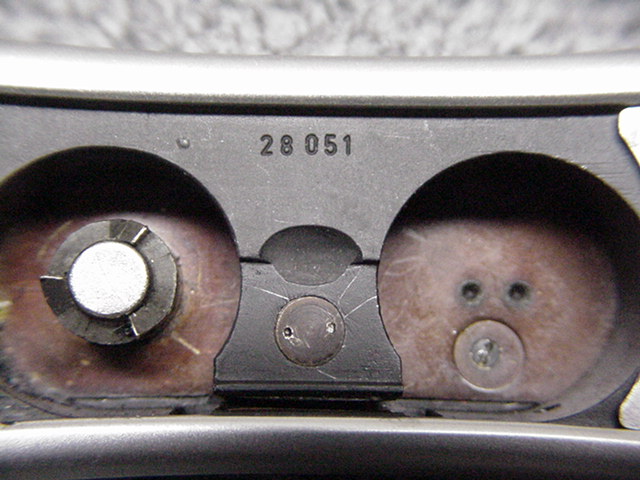
Minox II Chassis with Film Lens Intact
What is a Minox Model II?
The post-war Minox camera began its production at serial number 20,000 and was named at the factory the Model A. This nomenclature continued until the end of production at about serial number 147,494. In Europe, the cameras in this range were all called Minox Model A cameras. In the USA and for export, later Model A cameras were also known as the Model III and IIIs (the "s" means it includes a flash sync plug). The Model II is a bit of an anomaly. It actually became known as the Model II after the introduction of the Model III and therefore none were actually marked Model II. The change from the "troublesome" 5 element lens camera to the improved 4 element lens which took place somewhere in the vicinity of serial number 31,500 is what most people regard as the transition to the Model III. Both the 5 and 4 element lenses were called "Complan" so there was no difference in the labeling on the front plate of the camera.
I call the 5 element lens troublesome because it utilized a glass element at the film plane (known as the "film lens") which actually contacted the emulsion coating of the film when the pressure plate would press the film into its shooting position. This lens was nearly impossible to clean without disassembly of the camera and any contamination of this piece of glass with dirt or grit would result in poor photos or scratched film and was almost immediately recognized as being less than ideal. Here are some photos to illustrate what the film lens looks like. The top photo is the back end of the chassis of a Model II with the film lens intact. The lower photo compares a close-up of the film gate of the Model II with a later chassis from a Model III which does not have the film lens.

Minox II Chassis with Film Lens Intact

Close-ups of film lens installed in Model II (top image) and standard film gate
from Model III (bottom
image)
After the change to the 4 element lens, all of the cameras made with the 5 element lens were retroactively referred to as the Model II since the Model III designation was reserved for the 4 element lens cameras. So, technically, there are approximately 11,500 Model II cameras, or should I say there were that many produced with the 5 element lens. Minox undertook to "improve" the cameras made in the 20,000-31,500 by retrofitting them with the 4 element lens when the cameras were returned for service over the years. Apparently this was done sometimes without the owner's knowledge but out of Minox own pride in having discovered the faulty lens design and wanting to improve it. While this is a noble intention, it effectively alters the camera to make it indistinguishable from the Model III in terms of its technical design. It also makes a real Model II camera, one with the film lens left intact, far rarer than the 11,500 number would imply. How many actually exist today is anybody's guess...I would guess about 1,000-2,000 based upon the fact that most of the 11,500 were "retrofitted" to a Model III and many others just have not survived the 50 years since their production.
I am often asked "how can I tell if my camera is a Model II which has been retrofitted to a Model III or if it is still a Model II?". In order to answer that conclusively you would have to disassemble the camera and examine the film gate itself as shown in the photos above. Some purport to have success with a test which does not require disassembly whereby they insert a bent piece of wire between the film pressure plate and film gate (where the film would normally lay) and "feel around" for the film lens by twisting the wire. Personally, I have had poor results from using this test because finding wire which is thin enough to fit in the space between the pressure plate and film gate that does not bend and distort when twisted has been nearly impossible. I have never had reliable results from testing with this method. Also, I fear that the wire would scratch the film lens if it was present. For these reasons I do not recommend this test. I have included a photo of the film compartment from a Model II, below.

Note the presence of the "porthole" just above the film gate. Some people think this was used to clean the film lens, but this is incorrect. The purpose of the porthole was to aid in the testing of the shutter by inserting a probe into the hole and allowing a light path for the shutter tester without the need to disassemble the camera. The later models used a reflective tester which made the porthole obsolete. Interestingly, the earliest Minox II cameras did not have the porthole. I have seen cameras up to serial number 20 550 which were without this feature. I don't know exactly at what serial number it was added except that it was above 20 550. The feature was deleted in the early 30,000's so about 10,000 were probably originally made with the porthole.
There are some inconclusive tests which can lead one in the direction of whether a particular camera could still be an intact Model II or not. Those are based upon other design aspects which were unique to the Model II. The easiest to test is whether the filters automatically retract when the camera is closed or if they stay in position after re-opening the camera. The Model II apparently did not have automatic retracting filters (although after retrofitting the Model II with the 4 element lens, many were also retrofitted with the automatic retracting filters). Also, the early Model II cameras were equipped with shutter blades which were black in color and the cocking indicator was a silver dot in the center, which is the opposite of the later design being silver blades with a dark dot or circle to indicate the cocking status. If the camera in question has the dark blades and/or manually retracting filters then it could very well still have the film lens intact. I have seen cameras with these features whose film lens was removed, however, so this test is not conclusive. I have also seen many cameras which have the film lens intact but have the silver shutter blades, so this indicator is not conclusive either. Some of the retrofitted cameras are actually marked with the "III" designation on the bottom. I have never seen one marked "III" which was not retrofitted, so perhaps this is the one conclusive designator which can prove that a camera is NOT an intact Model II solely by visual examination.
In conclusion, the one aspect of design which makes a particular camera a Model II and differentiates it from the Model III is the 5 element lens. A camera which still has this lens intact is indeed a rare find and one which most collectors would treasure owning. Finding one which is original is very difficult and it is nearly impossible to know conclusively that the lens is intact until the camera is opened and examined for the presence of the film lens. Many sellers will refer to any camera in the 20,000-31,500 serial number range to be a Model II, but this is not 100% accurate. I would refer to any retrofitted camera in this range as a Model II/III and reserve the Model II designation only for those cameras that retain the original 5 element film lens. I hope this presentation clears up some of the confusion surrounding the Model II and its various incarnations.
The entire content of this site (text and photos) is © 2003, all rights reserved